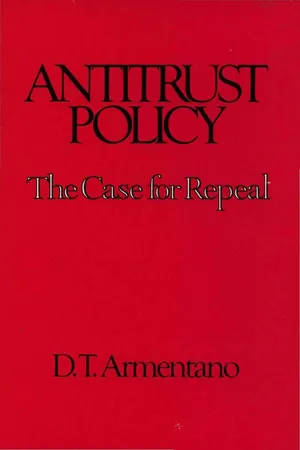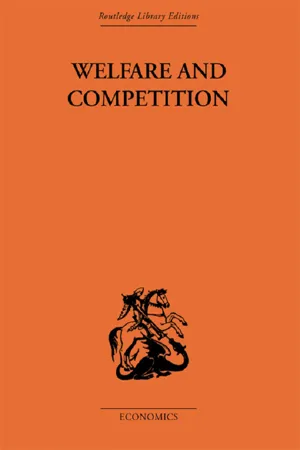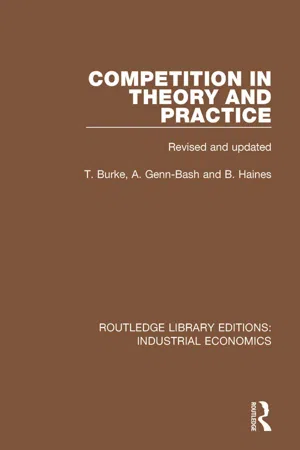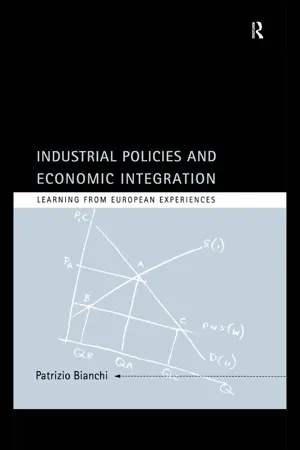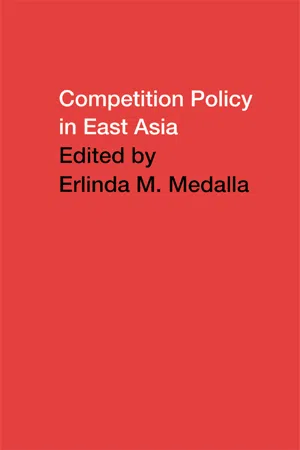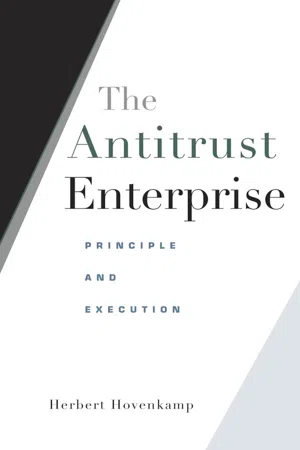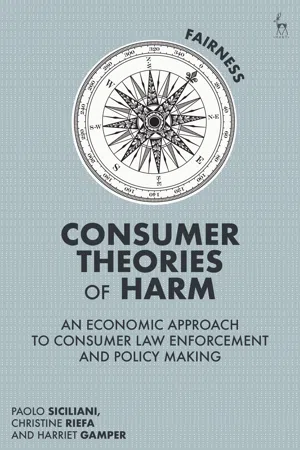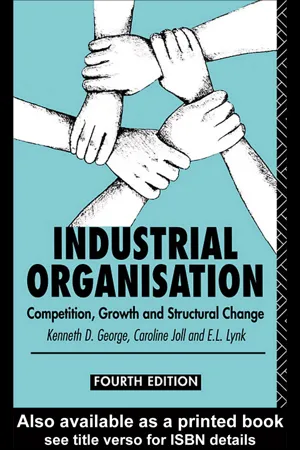Economics
Restriction on Competition
Restriction on competition refers to any action or practice that hinders or limits the ability of firms to compete in a market. This can include collusion, price-fixing, monopolistic behavior, or barriers to entry. Such restrictions can lead to reduced consumer choice, higher prices, and decreased innovation within an industry. Regulatory bodies often aim to prevent and address these restrictions to promote fair competition.
Written by Perlego with AI-assistance
Related key terms
8 Key excerpts on "Restriction on Competition"
- eBook - ePub
Antitrust Policy
The Case for Repeal
- D.T. Armentano(Author)
- 1986(Publication Date)
- Cato Institute(Publisher)
Competition and Monopoly: Theory and Evidence Much of the support for antitrust policy depends upon the correctness of the standard theories of competition and monopoly. These can be briefly summarized as follows.The Theories
Some economists define "competition" as a state of affairs in which rival sellers of some homogeneous product are so small— relative to the total market supply—that they individually have no control over the market price of the product.1These atomistic sellers take the market price as given and then attempt to generate an output that maximizes their own profit. The final outcome (equilibrium) of such a market organization of firms is that consumers obtain the product at the lowest possible cost and price. Such markets are said to be "purely" competitive ("perfectly" competitive if there is perfect information), and resources are said to be allocated efficiently.Free-market monopoly involves some voluntary restriction of market output relative to the output forthcoming under competitive conditions. Economists usually assume that "monopoly" means that there is only one supplier of a product with no reasonable substitutes or that several major suppliers of a product collude to restrict production. The economic effect of such monopolization is that market outputs are restricted—the monopoly "restrains" trade— and prices are increased to consumers. Such restrictions of production are also said to misallocate resources and reduce social welfare.The expression "misallocation of resources" is a powerful one in economics. It signifies that scarce economic resources are not being put to their greatest economic advantage. The implication is that some alternative allocation of these resources could improve overall economic performance.Monopoly is said to misallocate resources in two fundamental ways. The first is termed "allocative inefficiency." It implies that the price consumers pay for a product under monopoly—the monopoly price—exceeds the marginal cost of producing that product. Consumers indicate their willingness to have suppliers produce more of some product by paying a price that exceeds the marginal cost of producing it. Firms with monopoly power, however, can maximize their profits by restricting their production and keeping their prices up. Suppliers with monopoly power are said to have no incentive to expand production to the point where market price and marginal cost are equal. The consequence of such supply decisions is that resources are at least somewhat misallocated and social welfare is reduced. - eBook - ePub
- Tibor Scitovsky(Author)
- 2013(Publication Date)
- Routledge(Publisher)
XIV . The only difference between the two cases is that under free competition the price maker’s profit attracts to his market new competitors whose entry in turn tends to eliminate his profit; whereas under simple restricted competition the entry of newcomers is limited, which prevents the elimination of the price maker’s profit.2. MONOPOLY
At the other end of the scale from simple restricted competition is monopoly. This is the strongest restraint on competition and signifies the concentration of control over all or the most important market decisions in the hands either of one firm or of a group of firms acting in concert.2a. THE ESTABLISHMENT OF MONOPOLYMonopoly can come about naturally, as in the case of natural monopolies or when a group of competitors voluntarily fuse their interests to form a combination; but often—and perhaps more often—it is imposed, either by the state or by an exceptionally strong firm.The state may create monopolies for a variety of reasons. The earliest state monopolies, such as the salt and iron monopolies of the Han Dynasty in China, and the salt and tobacco monopolies of France, Austria, and several other European countries, were established to secure monopoly profits for the state itself. In sixteenth- and seventeenth-century England the Crown created monopolies in favor of private persons, often as a reward for services rendered. State monopolies have also been established in fields where competition could not be expected to prevail and where it was therefore felt that the price maker’s bargaining strength should be limited by public control. Hence the state monopolies of the telephone, telegraph, and public utilities in most European countries. State monopolies may also be imposed where, for one reason or another, private ownership is deemed incompatible with public welfare. This explains the state monopoly of broadcasting established in England in 1930 and most of the French and British nationalization measures of the recent past. - eBook - ePub
- Terry Burke, Angela Genn-Bash, Brian Haines(Authors)
- 2018(Publication Date)
- Routledge(Publisher)
6 A Practical Guide to Anti-competitive PracticesEarlier chapters have shown that competition can be defined in a number of ways. It follows that it is not possible to make a definitive economic statement as to whether a particular practice is ‘pro’ or ‘anti’ competitive. However, this theoretical difficulty has not prevented nation states legislating against ‘anti-competitive practices’, as Chapter 5 explains. The purpose of this chapter, therefore, is to seek to provide some insight into practices which have been deemed to have, or likely to have, ‘the effect of restricting, distorting or preventing competition in connection with the production, supply or acquisition of goods or services’ (Competition Act, 1980, s.2).PRICING POLICIESThis first set of practices are those which are arguably the most clearly anti-competitive yet are frequently the most difficult to detect. The laws of supply and demand require that manufacturers manipulate the output level to ensure profit maximisation within changing markets. While the theory of monopoly predicts that single producers will restrict output to ensure the maximisation of monopoly rents, the position of a dominant supplier with perhaps a 30 per cent market share is less clear-cut.Price fixingPrice fixing is the practice of firms agreeing either formally via some form of collusive agreement, or informally, to set prices at a particular level. Horizontal price fixing (collusion, cartels and like agreements) and vertical price fixing (resale price maintenance) are per se illegal within the United States, Japan, the UK and the EEC, but in the last three legislatures opportunities exist for certain types of agreement to be granted an exemption.Horizontal price fixing enables manufacturers to reduce competitive pressures and risk. Thus the European Commission has invariably taken the view that price fixing benefits only producers, and all attempts to claim consumer benefit – the primary basis for exemption under Article 85(3) – have so far been rejected. Parallel pricing is regarded as part of the same type of conduct, with the EEC regarding gatherings of industrialists in the same line of business as sufficient proof of prohibitable conduct – a most recent example is the Commission’s decision against six polypropylene manufacturers (OJ L230, 18.8.86). Neither UK or Japanese enforcement has been quite so scrupulous. - eBook - ePub
Industrial Policies and Economic Integration
Learning From European Experiences
- Patrizio Bianchi(Author)
- 2002(Publication Date)
- Routledge(Publisher)
The scope of the application of the Community rules therefore covers either the actions of single firms or government interventions which cause a change in intra-Community trade, and instead leaves to national authorities the task of dealing with restrictive actions at the strictly local level. Moreover, certain special sectors are removed from the scope of these general regulations, and are instead covered by specific Community regulations or agreements.Public interventions designed to promote competition in fact cover a wide spectrum of actions, which strike at the heart of the relationship between public authorities, firms and citizens. This is of particular relevance in Europe, where the single national markets have traditionally been considered so small as to induce governments to favour internal concentration in order to produce national firms capable of competing efficiently on the European market.On the other hand, the very completion of the internal market requires a careful tutelage of the market in order to ensure that the search for conditions of individual efficiency does not lead to restrictive practices and concentration of production, which are harmful to the overall efficiency of the market and of the political system.Collusion and Restrictive Practices
Article 85 consists of three paragraphs, which respectively lay down the following provisions:- concerted actions aimed at stifling competition are prohibited;
- restrictive agreements are declared invalid;
- exemptions to the above provisions are defined.
Article 85(1) in particular establishes that all agreements among firms, as well as decisions taken by associations, and concerted actions which may have the effect of altering competition among member states and which aim to or effectively prevent, restrict or distort competition are incompatible with the single market. The following in particular are prohibited: - eBook - ePub
- Erlinda Medalla(Author)
- 2004(Publication Date)
- Routledge(Publisher)
A particularly important focus of competition advocacy activities is in relation to regulation. To be sure, in both developed and developing economies, regulation can serve valid efficiency-related public purposes. For example, it is well established that regulation can be an efficient response to market failures such as imperfect information, the existence of a natural monopoly (a situation in which a market is most efficiently supplied by a single firm) and other such problems. Nonetheless, it is important to recognise that, notwithstanding its avowed aims, regulation often thwarts rather than promotes efficiency and economic welfare. This is likely to be the case, for example, where it imposes restrictions on entry, exit and/or pricing in non-natural monopoly industries. Experience in both developed and developing countries shows that, in many cases, rather than having regulation imposed on them for the public benefit, incumbent firms have sought regulation for their own benefit, for the purpose of limiting entry into the industry and helping them to enjoy higher prices for their products (the classic diagnoses of this problem are presented in Stigler 1971 and Jordan 1972). Recognition of the significance of such conduct as a barrier to economic development dates back at least to Krueger (1974), and is affirmed in recent analyses by the World Bank and other development-related agencies (see, e.g., World Bank 1997; UNCTAD 1998). In the light of this, efforts to remove inefficient regulatory restrictions and related interventions are central to the establishment of healthy market economies in developing and transition economies (World Bank 1997; World Bank 2000; Frischtak 1995).In the discussion in the WTO Working Group on the Interaction between Trade and Competition Policy, important links have been made between competition advocacy, successful efforts at regulatory reform and external trade liberalisation. The following examples of regulatory situations having adverse effects on competition and trade have been noted: outmoded or unnecessary regulations; a failure by countries to recognise each others’ technical standards; state zoning laws or sanitary and phytosanitary requirements that limit entry unnecessarily or serve as disguised tools for excluding competing suppliers; legal systems that facilitate strategic use of courts by firms to harass competitors; and discriminatory research and development funding. The following additional categories of regulation have been mentioned as warranting appropriate reforms: regulations that openly discriminate in favour of domestic suppliers; regulations that are non-discriminatory on the surface but subtly discriminatory in their substantive requirements; regulations that simply are no longer needed; and poorly designed regulations that are desirable in principle but unnecessarily intrusive. The potential contribution of competition advocacy in addressing these measures has been emphasised (WTO Working Group on the Interaction between Trade and Competition Policy 1998, paragraphs 110 and 111). - eBook - ePub
The Antitrust Enterprise
Principle and Execution
- Herbert Hovenkamp(Author)
- 2008(Publication Date)
- Harvard University Press(Publisher)
The antitrust laws are only one among many legal regulators of competition and innovation. Intellectual property laws and market-specific regulations for such areas as telecommunications or electric power also pursue the same ends. Furthermore, these alternatives come not only from the federal government but also from state and even local governments. One good way to think of antitrust is as a “residual” regulator; its purpose is to promote competition to the extent that market choices have not been preempted by some alternative regulatory enterprise. Much of antitrust decision making is concerned with the proper allocation of regulatory power between the antitrust laws and other legal regimes, such as the intellectual property laws, federal telecommunications law, state regulation of public utilities, or municipal regulation of land use.While we often think of antitrust as troubled by high prices, it is better to think of antitrust’s main concern in terms of restrictions on output. Competition is injured when a firm or group of firms is able to reduce output in some market, and “output” can be measured by either quantity or innovation.1 A restraint on output, such as a cartel, forces prices up because the same number of customers must chase fewer goods. A restraint on innovation forces customers to accept an inferior good, service, or method of distribution when an unrestrained market might produce something better.Using the law to create competitive incentives is a tall order. Speaking very generally, one would describe the market circumstances that facilitate price competition as several firms in the market, unrestricted entry, product homogeneity, good information held by both producers and consumers, and strong rules against price-fixing. But as soon as innovation is thrown into the mix, the story becomes more complicated. Innovation—and also the intellectual property laws that protect it—can produce market power, and even monopoly in extreme cases. Furthermore, the set of market structures that produces aggressive price competition is often quite different from the structures that encourage significant innovation. Much, perhaps most, profitable innovation occurs in relatively concentrated markets with a relatively small number of firms producing distinguishable products. Optimal pricing may require firms to compete with each other, but optimal innovation may require a more complex mixture of competition and cooperation. And patents and copyrights sometimes constitute formidable barriers to entry.2 - eBook - ePub
Consumer Theories of Harm
An Economic Approach to Consumer Law Enforcement and Policy Making
- Paolo Siciliani, Christine Riefa, Harriet Gamper(Authors)
- 2019(Publication Date)
- Hart Publishing(Publisher)
3 The Limitations of Competition Law in Tackling Consumer HarmI. IntroductionHaving considered the limitations of consumer law and its enforcement in the previous chapter, we now move on to consider the limitations of EU and national competition law.The dominant market-based paradigm portrays consumer protection as complementary (if not subordinate) to competition policy, where demand-side interventions are typically aimed at reducing consumer search and switching costs. The increased responsiveness of ‘informed consumers’ shall therefore provide the market discipline needed to make sure that competitive rivalry works well in the interest of consumers.1 This consumer welfare model was part of the modernisation reform of European competition law during the early 2000s. This is what underpinned pursuing a ‘more economic’-based approach to enforcement, aimed at maximising economic efficiency as opposed to protecting less-efficient competitors.2The ‘more economic’ approach to intervention is often contrasted with the idea of ‘freedom to compete’ and the standard requiring dominant firms to behave ‘as if’ they are subject to competition.3 Under the ordoliberal analytical framework, competition law is seen as an instrument for the preservation of the competitive structure of the market, rather than being exclusively concerned with consumer welfare, and thus the protection of consumers from exploitation.4 The following quote from the opinion of Advocate General Kokott in British Airways is emblematic of this approach to competition law enforcement:[Article 102] forms part of a system designed to protect competition within the internal market from distortions. Accordingly, Article [102 TFEU], like the other competition rules of the Treaty, is not designed only or primarily to protect the immediate interests of individual competitors or consumers, but to protect the structure of the market and thus competition as such (as an institution), which has already been weakened by the presence of the dominant undertaking on the market. In this way, consumers are also indirectly protected. Because where competition as such is damaged, disadvantages for consumers are also to be feared.5 - eBook - ePub
Industrial Organization
Competition, Growth and Structural Change
- Kenneth George, Caroline Joll, E L Lynk(Authors)
- 2005(Publication Date)
- Routledge(Publisher)
et al . 1979) also found that there was no significant difference between the profitability and other performance aspects of a group of firms that had been affected by the abandonment of restrictive agreements and those of a group that had not been affected by restrictive practices legislation. Although there are several methodological problems with these studies, the results are not entirely surprising. In general, the firms affected will usually be reluctant to embrace price competition wholeheartedly and will adopt any one of a number of devices to avoid this. Competitive behaviour will be most likely when the industry contains a large number of firms, including new entrants, and when the economic climate is buoyant. In other circumstances firms may attempt to restrict the degree of competition by entering into a new and legal form of agreement, or by recognising a price-leader or by some other form of oligopoly behaviour.Many firms, previously party to an illegal agreement, will seek to replace this with a less restrictive form of agreement that will offer some of the same advantages of reduced uncertainty. The most common form of agreement entered into in these cases is an information agreement, by which the firms in an industry exchange information on prices, costs, investment plans, and so on through a central agency, but no agreements are made between the firms themselves on these matters. The prevalence of information agreements, where more restrictive agreements have been abandoned, has forced both the USA and the UK to evolve a policy towards such agreements. The Restrictive Trade Practices Act 1968 made information agreements registrable in the UK, which means that details of the agreement are available to all concerned, but as yet no cases involving information agreements have been heard by the Restrictive Practices Court. US anti-trust policy has evolved guidelines to decide whether an information agreement is restrictive or not. In order to be allowed to continue, the information exchanged under an information agreement must be available to all buyers and sellers, must not identify individual companies, must cover only past sales, must not circulate average prices, and must not contain any controls or penalties on sellers. In the EC, information agreements have been included in the general prohibition of Article 85 from the outset of policy, and in several cases such agreements have been disallowed.
Learn about this page
Index pages curate the most relevant extracts from our library of academic textbooks. They’ve been created using an in-house natural language model (NLM), each adding context and meaning to key research topics.
